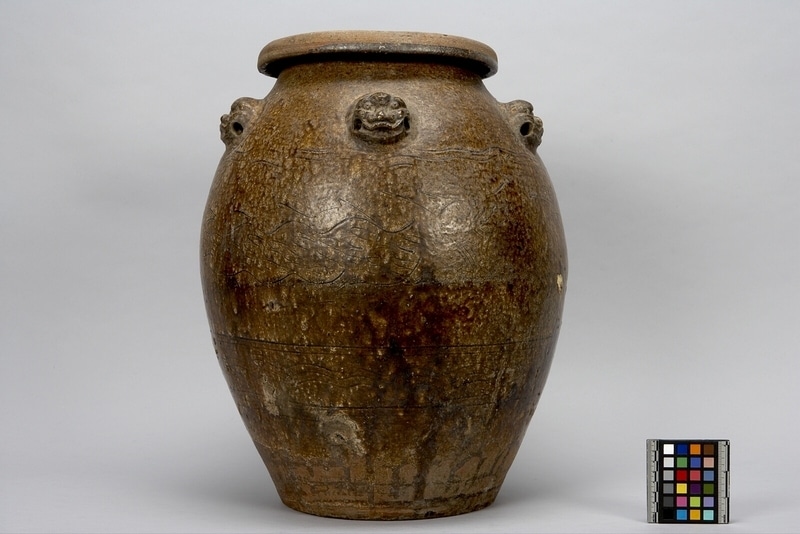Jar Item Number: Ia257 from the MOA: University of British Columbia



Description
A large globular jar with wide mouth, thick overhanging lip and five lugs in the shape of lion heads. The main body motif is a pair of incised dragons each chasing a round object and bordered by wave patterns. The interior, mouth and underside are unglazed. The underside has a thick layer of white plaster. A set of inked numbers on lip.
History Of Use
Chinese ceramics were important trade items in Southeast Asia during the 11th - 16th century C.E. This jar was probably exported from China to the Philippines via the Burmese port of Martaban from which the generic name for large jars is derived. They are also referred to as dragon jars because they often have a moulded dragon decoration on their sides. These pot-bellied jars were designed for long journeys at sea, with lugs big enough to pass a rope through and as containers for food, oil and water as well as for packing smaller porcelains. Besides China, Martaban jars were also manufactured in other parts of Southeast Asia such as Burma, Cambodia, Thailand and Vietnam and are still being manufactured today in parts of Asia. Due to their physical characteristics - resonance, vitreosity and durability - Chinese ceramics became fully integrated with the ideology and ritual in Philippine societies and played an important role in all aspects of cultural life (Langrick, p.61). Their functions were varied and included utilitarian, ceremonial, religious roles, as heirlooms, in mortuary ceremonies as burial goods and as items of prestige. Treasured for their supernatural powers, large jars were considered to harbour spirits or household gods while some spoke prophesying events. As heirlooms, large jars together with stories of their origins and other tales associated with them, often mythical and wondrous, were handed down from one generation to another. With age, jars increased in value and one's wealth was largely reflected in the number of old jars possessed.
Cultural Context
exchange; status; ceremonial; heirloom.
Narrative
An heirloom piece defined by Dr. Tecson as a piece never in the ground, thus different from an excavated piece, and not necessarily from his family. This jar is from Zamboanga del Sur, Mindanao Island.
Specific Techniques
Probably hand-built with clay rings of varying sizes. These were fused together by holding a mallet with a convex face against the inside surface of the jar and tapping gently with a concave mallet held against the outer surface.
Iconographic Meaning
In many indigenous groups of the Philippines, supernatural power was attributed to Chinese ceramics because of the ringing sound emitted when lightly tapped and their vitreous, shiny glazed surfaces which impart an impermeable quality. The ringing sound was seen as a magical voice able to attract the attention of powerful ancestor spirits. Their impermeable and seemingly imperishable surfaces were believed to have great protective power against all kinds of influences, from evil spirits to poisons (Langrick, p. 55-56). While the dragon is a traditional Chinese symbol embodying the yang or male principle and emblematic of good fortune, it is also associated with the mythical Naga serpent by the peoples of Southeast Asia. Dragons frequently occur in pairs with each chasing a round object variously interpreted as sun, moon, pearl or the yin yang emblem. The lion is sacred in Buddhism and is an emblem of bravery and strength.
Item History
- Made in Zamboanga Del Sur, Philippines between 1368 and 1644
- Owned by Julia Tecson and Miguel Tecson before November 16, 1987
- Received from Julia Tecson (Donor) and Miguel Tecson (Donor) on November 16, 1987
What
Who
- Culture
- Philippines
- Previous Owner
- Julia Tecson and Miguel Tecson
- Received from
- Julia Tecson (Donor) and Miguel Tecson (Donor)
Where
- Holding Institution
- MOA: University of British Columbia
- Made in
- Zamboanga Del Sur, Philippines
When
- Creation Date
- between 1368 and 1644
- Ownership Date
- before November 16, 1987
- Acquisition Date
- on November 16, 1987
Other
- Item Classes
- ceramics
- Condition
- good
- Accession Number
- 1262/0008